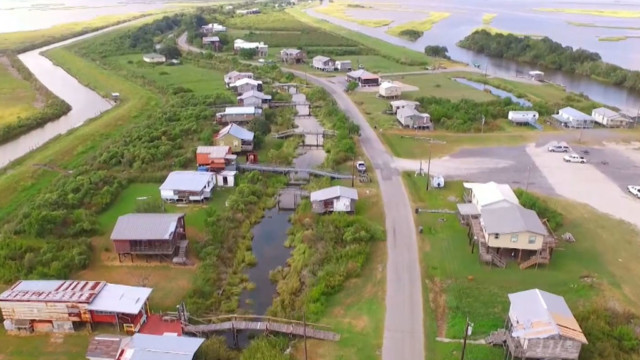The world’s second biggest emitter of greenhouse gases is expected to walk away from the Paris Climate Accord. How will U.S. President Trump’s decision affect the world and the people in his own country?
CGTN’s Sean Callebs went to the tip of the southern U.S. state of Louisiana to look at the impact of rising tides for our series Beyond the Beltway.
It doesn’t look like it, but a small island, on the far southern tip of the state of Louisiana, is in the eye of a storm.
68-year-old Edison Dardar’s lifestyle is in peril. “I catch some shrimp, sometimes a couple of crabs, sometimes a little redfish,” he said. “I mean, they got everything you want here.”
Culture and history are at risk as forces of nature combine, threatening to devour what’s left of this strip of land called Isle de Jean Charles.
Dardar is Native American, a member of the Biloxi-Chitimacha-Choctaw tribe, which was forced to settle in the far southern reaches of Louisiana close to 180 years ago. But this land is being washed away.
Thomas Olivier, an Isle de Jean Charles landowner, points out one part of the island. “This right here,” he gestured, “twenty years ago you couldn’t even see the water. Now, it’s a lake.”
Olivier has seen a dramatic change. His family’s old black and white photos provide a glimpse of what used to be—hardwood trees, as far as the eye could see.
The vast piece of land is disappearing due to salt water intrusion as well as canals carved through marshlands for oil and gas exploration. What used to be about 13,000 hectares is a mere 130 today.
Olivier has always counted on leaving his house and the land to his grandchildren. “Oh yeah, they are going to inherit all that,” he said.
But when asked what will be left for his children to inherit, he hesitated before responded with, “Well, I don’t know.”
A couple of years ago, the U.S. federal government authorized $48-million to move Dardar and several dozen land owners further inland, providing housing, a recreation center, and a church.
Under the plan, these so-called casualties of climate change would be moved collectively – as a community – not scattered to the wind.
But Dardar is among those pushing back. “If you move, like, me, I’m 68 years old. If I go live, sure—I’d be die (sic) when I’m 70,” he said. “What am I gonna do there? No water, what to do? Sit down and watch television?”
The only thing keeping the water from taking the rest of the island is a two-meter high levee that can’t be maintained forever.
It’s pretty clear that the isle is losing its fight against the rising tide. Even a glancing blow from a powerful storm—such as Hurricanes Harvey, Irma, or Maria—could overwhelm the earthen levees protecting Isle de Jean Charles.
Residents are often called the first climate refugees in the United States. However, while they may be the first, they are hardly alone.
How and where to go rests squarely on the shoulders of Albert Naquin, a tribal chief.
Chief Albert, as he’s known, wants to relocate people from the Isle to the town of Houma, Louisiana—about an hour’s drive inland. But the 71-year-old is finding a battle on many fronts.
“I’m in a no-win situation. There are people against me, and they’re gonna stay,” Naquin said. “I do believe—I still have faith that we will succeed. I mean, maybe not 100 percent on what we had planned, but hopefully it is gonna be a lot better than what we have now.”
“If you visit Isle de Jean Charles today, and you had never been there, you may think ‘What’s the big deal? It’s just another spit of land with a few houses on it,” Mark Davis, director of the Bywater Institute at Tulane University said.
But researchers see what’s happening here in this part of Louisiana almost as a test case.
The question that’s on Davis’ mind is, “Is this translatable? Is what you do for a Native American community on a small island in Louisiana—is it translatable to a New Orleans? Or a Miami?”
Or Bangladesh, Indonesia, or other areas coping with coastal erosion from climate change? The plan is to move the residents, and then no longer maintain the levee or the utilities, allowing the sea to reclaim the land.
 CGTN America
CGTN America

